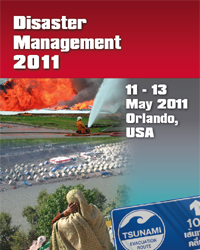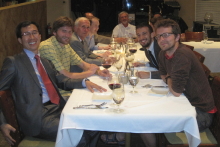Disaster Management 2011
2nd International Conference on Disaster Management and Human Health: Reducing Risk, Improving Outcomes
11 - 13 May 2011
Orlando, USA
Introduction
 The second International Conference on Disaster Management and Human Health Risk has taken place at the University of Central Florida organised by that Institution, represented by Professor Alain Kassab, and by the Wessex Institute of Technology (WIT) of the UK, represented by Professor Carlos A Brebbia. The meeting was also co-chaired by Professor Eduardo Divo of Daytona State College, Florida.
The second International Conference on Disaster Management and Human Health Risk has taken place at the University of Central Florida organised by that Institution, represented by Professor Alain Kassab, and by the Wessex Institute of Technology (WIT) of the UK, represented by Professor Carlos A Brebbia. The meeting was also co-chaired by Professor Eduardo Divo of Daytona State College, Florida.
Florida is not a stranger to the increasing number of natural disasters affecting millions of people around the world, having periodically suffered the ravages of hurricanes and typhoons. More recently, Florida’s economy was seriously affected by the Deepwater Horizon Oil Spill in the Gulf of Mexico in spite of its coastline being mostly spared.
The modern world in general faces a wide spectrum of threats from human-made disasters that can be attributed to the failure of strained and antiquated industrial and energy installations as well as deliberate sabotage from terrorists and vandalism during violent political upheavals. Added to this is the ever-present threat from natural causes ranging from biological pandemics to earthquakes and tsunamis.
The tragic events triggered by the Sendai earthquake and the ensuing tsunami that struck Japan resulted in devastating loss of life and property. Thousands of people perished and many more lost their properties.
These events confirmed the importance of this conference which attracted outstanding contributions from researchers throughout the world.
Opening Addresses by Professor Alain Kassab and Professor Carlos Brebbia
The conference was opened by Professor Alain Kassab who described some of the work taking place at the University of Central Florida. The Institution which has now nearly 60,000 students has grown rapidly in the last few years being the second in the USA in terms of students. It has a strong commitment to engineering with a substantial number of specialisations. The new development at UCF has been the creation of a medical school which is to be the nucleus of a Medical City comprising several hospitals and research centres. The university is also renown for its Centre for Optical Studies and Lasers and Solar Energy Laboratories. Following these remarks, Professor Carlos A Brebbia welcomed the delegates in the name of WIT and explained the motivation for his Institution to arrange this international conference series. These events, Professor Brebbia said, fitted with the commitment of WIT to act as a centre for knowledge transfer and promote international interdisciplinary cooperation amongst not only physical scientists but also those working in humanities, political, social and economic sciences. This has also led to WIT participating in large EU and other projects involving colleagues from a wide variety of disciplines.
Following these remarks, Professor Carlos A Brebbia welcomed the delegates in the name of WIT and explained the motivation for his Institution to arrange this international conference series. These events, Professor Brebbia said, fitted with the commitment of WIT to act as a centre for knowledge transfer and promote international interdisciplinary cooperation amongst not only physical scientists but also those working in humanities, political, social and economic sciences. This has also led to WIT participating in large EU and other projects involving colleagues from a wide variety of disciplines.
WIT believes that more of this work is needed to support the idea, it has launched a series of interdisciplinary Journals and books other than proceedings.
Professor Brebbia ended by describing some of the research and postgraduate training taking place in the WIT campus, located in the New Forest National Park, an area of outstanding beauty in the South of England.
Keynote Address by Dr Naim Kapucu
Carlos then introduced the Keynote Speaker, Dr Naim Kapucu, Director of the Centre for Public and Non-Profit Management at the University of Central Florida. The title of his talk was ‘Cross-section and inter-organisational networks for disaster resiliency and sustainability’.Naim spoke of the Emergency Services Framework (ESF) developed in the USA which coordinates the work of different organisations at the national and local level.
Florida – Dr Kapucu explained – has one of the best disaster management systems in the USA, as part of the collaboration of federal agencies and local governments, within what is called the Federal Response Framework. The experience of 9/11 and other disasters have also led to the emphasis on emergency management and collaboration of official agencies with private enterprise.
An important quality is to be ‘disaster resilient’, i.e. to have the capability to bounce back in the face of major disturbances. This is a function of the vulnerability of the region and resources available amongst others.

- Preparedness
- Mitigation
- Response
- Recovery
The important concepts are;
- Land use planning
- Resilience and adaptive capacity
- Social forces, capital and institutions
- Inter-organizational relations
Collaboration networks are required for disaster response with interdependent relationships, sufficient complexity, use of ICT and the appropriate continuity and sustainability.
The ESF system is triggered by the local authorities and has the following advantages;
- Proactive planning rather than reactionary response
- Resources optimization
- Better communications and decision making
- Better coordination
- Resources sharing
The system has been developed in response to the major disaster threat that the USA has faced in the last few years.
Invited Presentations
Following Dr Kapucu’s speech, there were other invited presentations at the meeting;
‘Promoting the hybrid socio-technical approach for effective disaster risk reduction in developing countries’
by D. Karnawati, Gadiah Mada University, Indonesia
‘Emergency Management for Higher Education Institutions’
by J. Morgan, University of Central Florida, USA
‘Wireless network sensors that are energy efficient for monitoring and early warning’
by V. Ferrara, University of Rome ‘La Sapienza’, Italy
Conference Sessions
The other papers were classified in the following sections;
- Disaster analysis, monitoring and mitigation
- Emergency preparedness
- Risk mitigation
- Surveillance and early warning systems
- Socio-economic issues
Conference Banquet
 The conference banquet took place at the end of the first day in a well-known restaurant located on the waterfront in Cape Canaveral Port. This is a unique environment combining a marina for recreational yachts, fishing vessels, commercial shipping, large cruisers and the NASA fleet which is used for rocket boosters and other missions. The lights of the rocket launching pads could be seen across the water, reflecting the type of activities that has made Cape Canaveral a household name all over the world. The delegates were able to taste the fish dishes for which the restaurant is renowned, accompanied by excellent wines. The occasion was very friendly.
The conference banquet took place at the end of the first day in a well-known restaurant located on the waterfront in Cape Canaveral Port. This is a unique environment combining a marina for recreational yachts, fishing vessels, commercial shipping, large cruisers and the NASA fleet which is used for rocket boosters and other missions. The lights of the rocket launching pads could be seen across the water, reflecting the type of activities that has made Cape Canaveral a household name all over the world. The delegates were able to taste the fish dishes for which the restaurant is renowned, accompanied by excellent wines. The occasion was very friendly.
Special Presentation on 'Emergency Management for Higher Education Institutions'
At the end of the second day, there was a special presentation on ‘Emergency Management for Higher Education Institutions’ by Jeff Morgan and Jennifer Fleischmann of the University of Central Florida, followed by a description of the UCF stadium facilities.
The region – Jeff Morgan explained - experiences a series of natural hazards, hurricanes, thunderstorms, wildfires and others. In addition, his Facilities and Safety Office deals with anthropological hazards: They are responsible for emergency mitigation systems, the actual infrastructure and the security management for the whole University Campus.
Following the talk by Jeff, Jennifer described the comprehensive Management Plan of UCF, which includes continuity of operations in case of disruption.
The delegates had ample opportunities for interaction during the meeting, including refreshments and lunches. They were also invited by the organisers to a special dinner at the end of the second day to strengthen their links and contribute to the success of the meeting.
Publication of Proceedings
The proceedings of Disaster Management and Human Health Risk II, 336pp (Print ISBN: 978-1-84564-536-6; Online ISSN: 1746-4498) are available from WIT Press priced at £145/US$232/€198. Orders can be placed on the WIT Press web site at www.witpress.com or by email:
Papers from the conference will also be hosted online at the WIT eLibrary as Volume 119 of WIT Transactions on the Built Environment (Online ISSN: 1746-4498). For more details visit the WIT eLibrary at http://library.witpress.com

 Wessex Institute
Wessex Institute